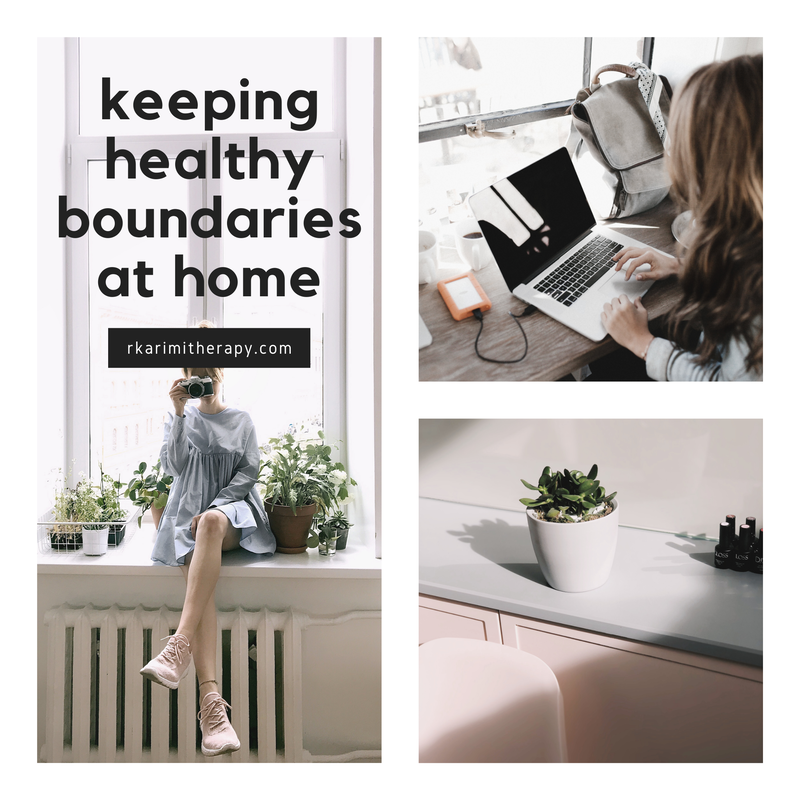|
With LA County extending the shelter in place order for another month we are WFH (in leggings) for at least the next month, which brings up many new challenges in work life. If you live at home with a partner, roomie, or family you might be thinking about pulling your hair out. Instead follow some of these to tips to set and keep healthy boundaries when working from home:
- set a designated space for each of your "offices" - set a time for lunch, if possible set the same times so you can meet in "the break room" to have meals together - establish a working guideline for calls and privacy - if you have kids schedule day care and work time separately, maybe you can trade off on who works and who parents - maintain a no news during working hours rule - get up every 2 hours and break for 10-15 mins> do a guided meditation, call a friend, get some fresh air, have some vitamins or citrus to keep immunity up - communicate that though you are working in close quarters you still need "you time" and space out when and how you can take that - use I statements to communicate what you need: "I feel frustrated when I'm on a zoom call and I can hear you playing video games in the back. Please respect that I am working." - remember this is TEMPORARY, release expectations of perfection and focus on doing what you can
0 Comments
Attachment begins with the infant-caregiver bond but it colors your whole world all the way into adult relationships. Learning about your attachment style will help you understand those deeply ingrained early childhood triggers and move toward a more secure attachment. Those with a secure attachment style have stronger, better bonds with people in their lives and are great communicators. They are able to form healthy relationships and hold appropriate boundaries of dependence and independence. Most importantly, they feel secure within themselves as the caregiver-infant bond also lends itself to the internalized voice.
If a child receives consistent attunement to their needs they learn how to best make sense of the world, how to trust, and how to self-regulate. This pattern becoming predictable helps the child interpret stress and learn to self-soothe, knowing their needs will be met rather than activating dysregulation in fear of abandonment or rejection. In childhood dysregulation looks like a fussy baby or a tantruming toddler and later in life it looks like an inability to manage emotions, to handle disappointment, rejection, or stressful situations. Trauma or inconsistent emotional, physical attunement can lead to insecure attachments making for difficult relationships with self and others. The good news? You can heal your attachment style through exploration in therapy in order to have better relationships and a more secure internal voice. There are two different styles of insecure attachment: anxious and avoidant. Those with an avoidant attachment, whether single or partnered always work to keep others at a distance. They long for a connection but feel a deep rooted aloneness and unconscious fear of abandonment and rejection that stops them. Their primal brain has reasoned that getting too close to people equals danger. An avoidant will suppress their feelings often ending in disconnection, loneliness, and pessimism. If you have dated an avoidant you may have had a really great date that you felt was emotionally intimate only to realize that your partner is now pulling away or becomes less responsive. They are feeling the closeness and a little bit afraid (a lotta bit). On the outside avoidants exude a level of independence and confidence that seems carefree. What it really is is a defense mechanism and a false sense of independence they have created to stave off the fear of their needs not being met. Instead they have simply chosen to suppress their needs and maintain distance in their relationships while internally longing for connection. This shows up as “deactivating techniques” in relationships when a partner romanticizes their time of singledom (forgetting how lonely they were), or maintains fantasies about a happier life and relationship with someone else. People who are in committed relationships but maintain fantasies about a “phantom ex” or have a list of unrealistic expectations in a partner. This sort of behavior keeps them at a safe distance for the price of true connection from others and themselves. Avoidants are uncertain, afraid of change, doubtful of others and their own choices. It is hard for them to know what the right thing is because they are constantly torn between the feeling of wanting to move toward closeness and the fear of rejection. Through therapy and becoming aware of your triggers and fears of true intimacy you can move toward a more secure attachment style. Avoidants are pulled toward anxiously attached people, which is a recipe for disaster masked in feelings of passion and chemistry, but they would do well with those who are securely attached. A securely attached person can help an avoidant communicate and can push for more intimacy while holding the right amount of space. The second type of insecure attachment is referred to as anxious attachment. Anxiously attached people suffer greatly in relationships, They never seem to be satisfied and are driven by fears of not being enough. They attach rather quickly but have difficulty fully trusting people in their lives. They are often seconds away from ending relationships but don’t for fear of being alone. They are unique in the sense that their primal brains have been hard wired to sense danger. Studies show that anxiously attached people are acutely aware of non-verbal communication and changes in tone and are able to accurately sense when their partners are pulling back. HOWEVER, they mess it up because of the amount of anxiety they experience when this happens. They go into “protest behaviors” trying to reestablish contact and receive attention. They jump to conclusions, react quickly, and in doing so they get it wrong. The best way for anxiously attached people to deal with conflict in their relationships is : TO WAIT. To let all their conclusions come and go and while doing coping strategies to manage the discomfort. Wait an hour and you’ll be much happier with your relationships and so will your partner. Anxious attachers struggle with this because they are not great self-soothers. They will be triggered and activated until receiving reassurance from their partners or friends that things are ok. They struggle to communicate their needs for fear of them not being met and thus being left alone. Instead they sense the danger are not able to communicate it and go into protest behaviors like: withdrawing, ignoring phone calls, keeping score of time in between messaging, they can be manipulative, and prone to incite jealously. Protest behaviors can be harmful for relationships and cause the anxiously attached person a lot of discomfort. These are people who often date multiple partners at once and are never fully satisfied in any of their relationships. It keeps them from reaching true intimacy but this is often unconscious to them as they feel distracted enough from their suppressed needs by forming many attachments. They would do well with securely attached people but find this person boring. We’ve all known someone who meets a “good on paper” person but doesn’t feel interested. They feel bored because they’re attachment style isn’t triggered and they take this to mean there is a lack of passion or chemistry. When really their needs are being met by an available partner and they do not know what to do with that. Anxious attachment styles are pulled toward the avoidant instead. Their triggers fit together so well but they have chaotic cyclical relationships. When these two styles come together they are able to reaffirm their beliefs about relationships. An anxious person wants closeness and intimacy, while an avoidant will want to maintain distance, and round and round they go until it becomes unbearable. They both fear the same thing, aloneness. Avoidants believe they are truly alone and anxious attachers are terrified of being alone (needs not being met.) Then there are the securely attached. Where are these people? And how did they get to be this way? Secures were raised with consistent care and attunement to their needs and have internalized safety and became hardwired to believe that their partners will be loving and responsive (what a concept right?!) They don’t run from intimacy and are able to get comfortably close while still maintaining their independence. They are secure in themselves and in their ability to handle conflict and express their needs. Anxious or avoidant persons who are in relationships with secure people are able to heal their attachment style and they report the same levels of happiness that two secures in a relationship report. However, this also means that a secure person in a relationship with an insecurely attached person can be made “worse”. Most of time a secure person will recognize that something is off in their partner and the relationship will be short lived because again, they believe that are deserving of respect and emotional intimacy. The best thing that an insecurely attached person can do when working to heal their attachment is to find a partner with a secure attachment style. Someone who can sit with you and understand your activating/deactivating techniques. To recognize when you’re lashing out and be able to redirect you in a compassionate and loving way. But the breadth of the work has to be done individually. As an attachment based therapist I work with clients to heal their attachment triggers through exploring caregiver relationships and raising awareness about the activating or deactivating techniques they use. It is important to become aware of your unconscious needs. If you have no idea, how can you ever communicate it with a partner? A therapist can help you learn how to communicate effectively. Communicating is scary for insecurely attached people because their underlying belief is that they will be rejected/abandoned for having needs. It is important to remember a securely attached partner will be able to hold space for your needs. How great would it be for an avoidant to be able to say “I need space” without fear or for an anxious to be able to say, “I feel jealous when you X and I need you to Y” in a non blaming but assertive way. I hope if love is on your mind today that you can sit with yourself and explore the triggers you have and think about what would help you move toward security. But most importantly, I hope you find confidence in yourself to ask for you need. |
Roxana Karimi
|


 RSS Feed
RSS Feed